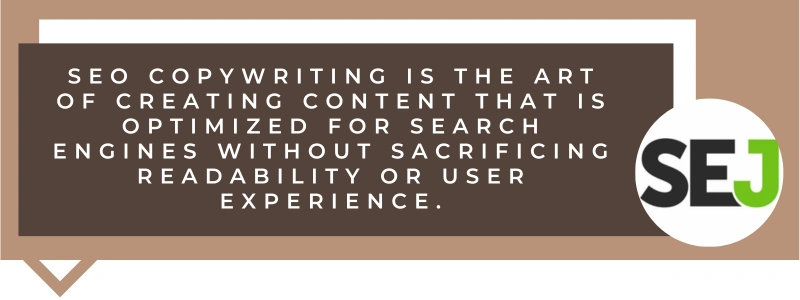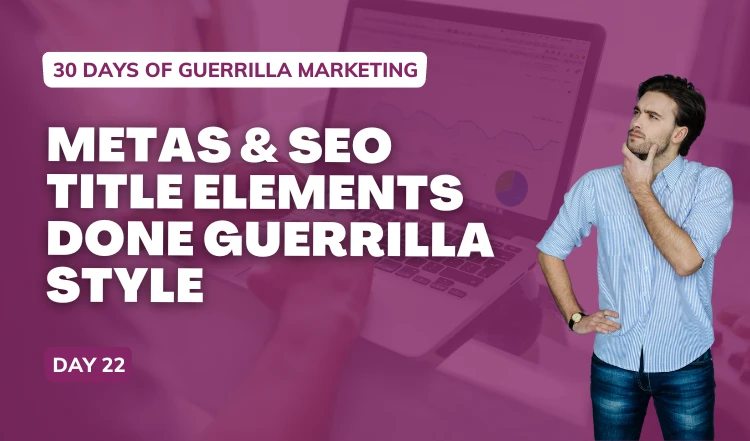Welcome to the third, and final, article in our series on Content SEO. If you missed the first two, you can catch up on them below:
And now onto the final piece of the content SEO puzzle, copywriting.
Copywriting for Content SEO
The final important aspect of a successful SEO strategy is copywriting. Your content should be well formatted, attractive, and easy to read or skim. You want people to come to your website and browse for a while.
At the same time, you want Google to value your content. In the past, some SEO strategies went too far with tactics like keyword stuffing, which made the optimization so overt that it wasn’t any fun to read.
Quality content is key and should come first in your strategy. Don’t adversely affect your content by adding too many keywords. Protect the readability of your text.
Start With an Original Idea
A good start for high-quality copywriting is to write content that is original. Your articles should be new and original. What you’re looking for is content that is inherently different from all the other content that exists on that topic. Write content that your audience wants to read.
If you did a good job on your keyword research, you probably have a pretty long list of terms you want to try to rank for. You can use this list as a guide of ideas to choose from. A keyword is not exactly a topic, but it can help to point you in the right direction. Come up with an original idea for your content which places the keyword in a prominent position.
Original doesn’t necessarily mean brand new in the world of SEO content. If your article is completely new, that automatically makes it original. But, giving your professional opinion on a topic can also count as original content. Your angle makes it unique and original.
Consider Your Audience
Writing original content means thinking about your audience and what information they’re looking for. Consider these questions:
- What do you want to tell or teach your audience?
- What’s the main message of your article?
- Will the reader recognize the purpose of your article?
- What would you like the reader to do once they’ve read the article?
Thinking about the answers to these questions, along with your keyword research, should give you some solid, original ideas for your blog posts or articles.
Readability
Your content must be easily readable. If visitors come to your site and are confronted by a solid wall of text, they’ll leave quickly.
Well-structured and clearly written content will help readers to understand your point, and it will also help search engines to understand your content. The more clearly search engines understand your message, the more likely it is that your content will rank well.
Readability includes many factors, including:
- Text structure
- Sentence length
- Clear paragraphs
In addition, you’ll want to consider skim readers and include plenty of bullet points and white space.
Before you start reading, consider these structure points:
- What do you want to tell your audience?
- What is the logical order you should place the topics in?
- Will the audience be able to easily understand and follow your arguments, examples, and message?
Other factors affect readability as well. Try incorporating these suggestions:
- When you can, use short and simple sentences for easier processing.
- Avoid difficult words – try writing at about a sixth-grade level.
- Always try to use the active voice.
- Write in an appealing, conversational style.
Writing easily readable copy is a skill that takes time to build. Copywriting for blog posts is a very different type of writing than what you were taught in school.
Once you’ve completed your content, always take a few minutes to read it aloud. If it sounds strange, or you must pause to clarify what you’ve just read, you should probably do a bit more editing before you hit the publish button.

Content, Context, and Search Intent
As search engines become smarter, they can understand the content on websites better. This is in part due to advances in natural language processing algorithms. Additionally, search engine AI now takes into account things like co-occurring terms and phrases, related words, and synonyms.
Search engines are now able to understand user queries better and determine the intent of the user. It can determine if you are looking for a product to purchase or just information related to that product, and then it tries to find the pages that fit that intent the best.
This means that you should change your focus from just trying to use your keywords a lot within your text to paying attention to the words you use around it.
Consider these points while writing your text:
- Is your topic clear within your text?
- Does your piece have a clear purpose?
- Are you providing information or a product to purchase, and does that align with what users are looking for?
Matching the intent of your content with the intent of the user is a key part of a great SEO content strategy.
Creating Intent-Based Content
When you’re ready to start creating your own intent-based content, try these tips for utilizing your keywords and other words that are related to them.
- Choose a keyword: Look over your list of keywords, choose one from your list, and search for it on Google.
- Analyze the results: Which intent is most common in the results? Is there a dominant intent? Are there videos, images, or related searches?
- Shape your content: Now that you know the general intent behind the keyword, create content that matches what users are looking for.
While your exact process may differ slightly, the idea is that it’s always a good idea to take a look at the SERPs for the key phrases you’re trying to target and then adjust your content accordingly.
Optimize Content for Readers and Search Engines
Findability is a term used to describe increasing the likelihood that search engines will take your content for the search engine results page. Optimizing your content for search engines is a requirement if you want your SEO content to be easily found by them.
There are a lot of tools available on the web to help you increase the findability and readability of your content pieces. While no one knows the exact algorithms used by Google and other search engines, some companies have a pretty good idea of what will give you the best results.
Final Thoughts On Content SEO
Content is a huge part of your SEO strategy. It not only matters what you write, but also how you write it and how you structure it on the page. No one will read your content if it’s terrible, and no one will even be able to find it if it hasn’t been optimized for the search engines.
Everyone knows that content is king. Striking the perfect balance between readability, findability, your audience, as well as the search engines isn’t the easiest thing you’ll ever do, but the results are so worth it.





